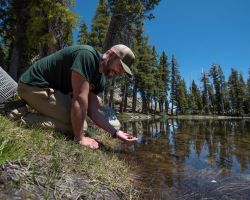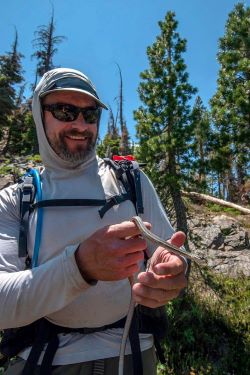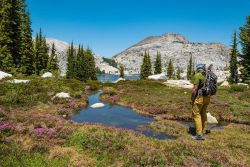Isaac Chellman recording data on a recaptured Sierra Nevada yellow-legged frog in Bucks Lake Wilderness, Plumas County.

Isaac Chellman releasing a zoo-reared Sierra Nevada yellow-legged frog in Desolation Wilderness, El Dorado County.

Isaac Chellman holding a mountain gartersnake in Desolation Wilderness, El Dorado County.

Isaac Chellman looking for Sierra Nevada yellow-legged frogs in Desolation Wilderness, El Dorado County.
Isaac Chellman is an environmental scientist in CDFW’s North Central Region, which includes much of the northern Sierra Nevada and Sacramento Valley. Isaac has worked for CDFW since 2017, leading the region’s High Mountain Lakes (HML) project.
Isaac is originally from the east coast, where he earned a bachelor’s degree in Wildlife and Fisheries Biology (’02) and later a master’s in Aquatic Ecology and Watershed Science (’11) from the University of Vermont. Following undergrad, Isaac worked for the U.S. Geological Service Amphibian Research and Monitoring Initiative at the Patuxent Wildlife Research Center in Maryland, and later for the USGS Brown Treesnake Project on Guam and the Northern Mariana Islands. In 2007, he was hired by the USGS for backcountry amphibian monitoring in Yosemite National Park. After that, Isaac worked for the Western Riverside County Biological Monitoring Program. After taking a few years off for grad school, Isaac returned to Guam as a crew leader for the Ecology of Bird Loss Project, a multi-island ecological study focused on the secondary ecological effects of native forest bird loss caused by invasive brown treesnakes. He also spent five years as the crew supervisor for the Aquatic Ecosystems Program at Sequoia and Kings Canyon National Parks, before coming to work for CDFW.
Who or what inspired you to pursue a career as an Environmental Scientist?
I’ve been captivated with the outdoors for as long as I can remember. Growing up in rural New Hampshire, I was usually outside, often in wetlands. I became really interested in amphibians (frogs, in particular), and that love of ectothermic critters stuck. My dad and aunt are probably my two biggest influences in helping foster an appreciation for the natural world. Dad would often take my brother and me out on hunting and fishing trips, both locally and further afield. My aunt was the head of the New Hampshire Fish and Game Department’s moose project for many years, until retiring a couple years ago. She was a big inspiration for me, and she definitely supported my pursuit of a wildlife career as I was planning to enter college.
What type of work do you do as a CDFW environmental scientist?
As part of the HML project, the seasonal field crew and I visit aquatic habitats all over the northern Sierra Nevada, monitoring the status and trends of frog populations, assessing fisheries and working to help conserve threatened and endangered species, in particular. Most of the specific projects I work on — which tend to be federally funded through section 6 of the Endangered Species Act, State Wildlife Grants or similar sources — focus on monitoring the various Sierra Nevada yellow-legged frog (Rana sierrae) populations in the region, and carrying out actions to help recover the species.
Part of that work involves targeted removal of introduced trout, which prey on R. sierrae in locations where the species overlap. Trout are a major contributor to declines of R. sierrae and Southern Mountain yellow-legged frogs (Rana muscosa). Introduced trout, including brook trout (native to the eastern U.S. and Canada) and rainbow trout (native to the west coast, but not originally found in many areas of the Sierra Nevada), were originally stocked into high mountain lakes beginning in the latter half of the 19th century. Other species of trout are native to parts of the Sierra Nevada (including Lahontan cutthroat trout, Paiute cutthroat trout, Little Kern golden trout, Kern River rainbow trout and golden trout). However, prior to the mid-1800s, most of the remote, high elevation lakes and streams did not contain any fish, which had been precluded by glaciation and natural barriers to upstream fish movement. During my time with CDFW, we have removed introduced trout from a few specific locations that contain small populations of R. sierrae nearby. In those places, R. sierrae have often been relegated to smaller, fishless waterbodies, since the frogs can’t effectively reproduce in areas occupied by trout. We use mechanical methods (gill nets in lakes and backpack electrofishing units in streams) to catch the fish, the carcasses of which are then sunk to the deeper portions of lake bottoms, where they break down and return nutrients into the ecosystem. Once the fish are removed, the habitat is again available for the frogs to reproduce without the threat of being suppressed by predators with which they did not evolve.
Other projects I work on include translocations and reintroductions of R. sierrae into remote, fishless lakes on public lands within the known range of the frogs. For example, in Desolation Wilderness, my colleagues and I have undertaken several frog translocations, using one of the more robust R. sierrae populations in the northern Sierra Nevada as the source, and moving some of the adult frogs to a fishless lake basin about two miles away. The recipient lake basin likely had R. sierrae in the relatively recent past, but the area had been stocked with brook trout for many years, and the frogs were no longer present. However, the fish died out in the absence of stocking, so we began a project in 2018 to reintroduce the frogs. So far, that effort has been really successful.
All the adult frogs we release are individually marked with passive integrated transponder (PIT) tags, which are tiny (8 mm long) inert microchips encased in glass, which we insert under the frog’s skin to give each individual a permanent, unique identifying code that we can detect using a handheld scanner. We closely monitor the newly translocated population: surveys involve catching every adult frog we find, scanning and recording their PIT tag, and collecting morphological measurements. Those measurements have revealed that the recaptured frogs have been growing quickly and appear to be very healthy.
All of this work, and more, is part of an Interagency Conservation Strategy for mountain yellow-legged frogs in the Sierra Nevada. The strategy was developed over several years by a dedicated team of biologists, managers and administrators with CDFW, the U.S. Fish and Wildlife Service, U.S. Forest Service, National Park Service, U.S. Geological Survey, university-affiliated researchers and several California zoos.
What types of invasive species do you encounter?
The main invasive species connection to the HML work is a fungal pathogen, often associated with aquatic environments, known as amphibian chytrid fungus (Batrachochytrium dendrobatidis), or just “Bd” for short. Bd causes an amphibian-specific disease known as chytridiomycosis, which has been a major contributor to amphibian declines (particularly in frogs). The disease has been linked to many frog extinctions all over the world. The exact origin of Bd, and all the ways in which it spreads, is not fully understood, but the current prevailing theory is that Bd was likely introduced to North America at least a century ago, and Bd later spread up into the Sierra Nevada, possibly around the 1960s or 1970s.
Bd is currently present throughout most of the Sierra Nevada. Scientists have detected the pathogen in many different species, but some frog species are more susceptible than others to developing chytridiomycosis. For example, American bullfrogs (Lithobates [Rana] catesbeianus), which are native to the eastern and central U.S. but invasive in California, are a known host for Bd. However, the pathogen doesn’t seem to affect bullfrogs very much, particularly when compared with many other frog species. There is a lot of concern that bullfrogs may act as a vector for spreading the disease to more susceptible native species in California, like Foothill yellow-legged frogs (Rana boylii), and lower elevation populations of montane ranid frogs, including Cascades frogs (Rana cascadae), R. sierrae and R. muscosa). There are also native species that appear to be less susceptible to Bd-induced mortality (and could, therefore, also be potential reservoir hosts for Bd), particularly chorus frogs (Hyliola [Pseudacris] spp.), which are often known simply as “treefrogs” in our area. Although many native species are highly susceptible to Bd, not all populations have the same outcome when the pathogen arrives. Some populations are able to persist, and even thrive, despite the presence of Bd, whereas others become extirpated (that is, the population in that particular area dies out). Investigating why there can be such differences in outcomes from Bd infection in various populations, even within the same species, is one of the biggest areas of scientific research surrounding the pathogen.
Although Bd is now fairly ubiquitous in California, there is still concern about moving the pathogen around, in part because there are many different genetic strains of Bd that have been recently identified in the Sierra Nevada. Since we roam all over the Sierra Nevada to study native California amphibians, my crew and I decontaminate all gear that came into contact with the aquatic environment, including shoes and socks, nets and sampling equipment. These efforts also help greatly reduce the chance we’ll move any other high elevation aquatic invasive species (AIS) or pathogens around, including things like Ranaviruses (another group of microorganisms that can affect frogs). Additionally, if we’re ever working in lower elevations areas that may have other AIS present, such as New Zealand mudsnails and quagga/zebra mussels, we also freeze our gear overnight after use, in addition to the other decontamination procedures.
What do you love about your job?
It probably won’t be a shock to know that I love the field work. Being able to study native amphibian populations throughout the mountains and foothills of the Sierra Nevada is incredible, and I don’t take that opportunity for granted. Knowing that I’m doing work that directly benefits native species, while doing so in some of the most beautiful landscapes in the country, is hard to beat. I also work with great people, and being able to collaborate with others toward common conservation goals is something I love about the job.
The translocation project I mentioned is one of the more recent work projects that I’ve found gratifying. That project has been a group effort, involving other biologists who have laid the groundwork, including conceptualizing the project and securing the initial funding, and other staff who have helped in the field, including many seasonal scientific aids and partner biologists with Eldorado National Forest. It has been rewarding to recapture many of the frogs we have released and see that they appear to be doing very well, and it has been particularly exciting to see new frogs entering the population. Seeing some initial successes like this is motivating and gives me hope that our projects, along with other great work by colleagues working throughout the Sierra Nevada, can help recover the species.
One other thing I really like about the projects we undertake is that they are relatively low cost, particularly given the benefits we can see. Monitoring, translocations and mechanical fish removal projects are pretty cheap when it comes to conservation work. We can do these projects using small crews, composed mostly of seasonal staff, with limited resources in relatively short periods of time.
What advice would you have for a young scientist wanting to do what you do?
If you’re thinking about pursuing this kind of work, it’s important that you feel fairly confident you’ll truly enjoy it, whatever your specific interest may be. If you are pursuing what you love to do, any potential challenges will be more endurable. In terms of practical needs, it’s important to obtain a baseline education in this type of work, particularly to meet the minimum qualifications many jobs require. It doesn’t need to be wildlife or fisheries biology, specifically, but the degree should have a related focus (for example, degrees in general biology, conservation biology, environmental science/studies, molecular ecology, genetics, zoology, etc.), and that degree could be from a local community college or elsewhere, depending on your desires and resources. With that as a baseline, if you have the ability, I highly recommend applying to all sorts of seasonal field jobs, and try working for different agencies/organizations, on different projects, and with different species, to see what you enjoy the most. It can be a long road of working for low pay and living in austere conditions, but it can also be a lot of fun, and rewarding life experience.
Another big piece of advice I have is to be persistent: do not give up, particularly when it comes to applying for those seasonal jobs. When you’re just starting out and trying to gain experience, it can take many applications before you get interviewed, let alone be offered a job. However, perseverance is huge, and you will eventually be able to land a job in your field, if you keep at it.
Photos courtesy of Isaac Chellman.